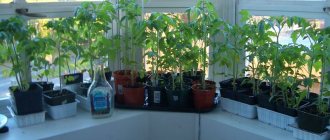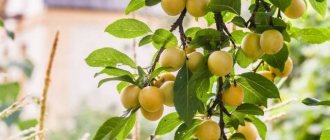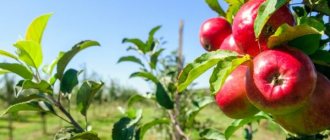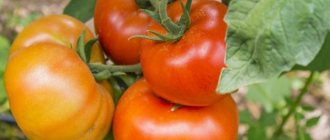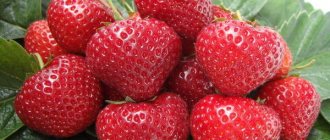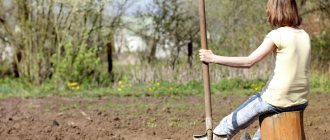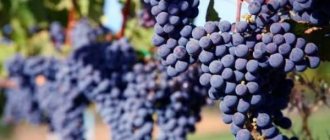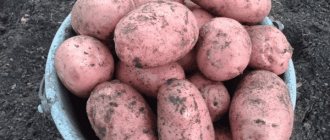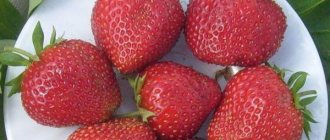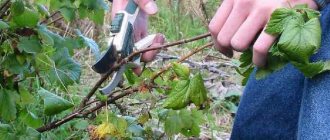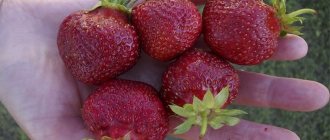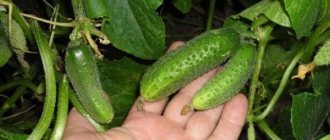Pear Williams.
Description of the variety
Williams is a representative of the group of summer ripening varieties. This variety is widespread in many countries, such as:
- Switzerland;
- England;
- Austria;
- Germany;
- Moldova;
- Ukraine;
- Russia;
- Georgia;
- Tajikistan;
- Kyrgyzstan.
Characteristics of wood
The trees are compact in size. The growth of an adult pear rarely exceeds 3 meters. The crown is wide-pyramidal, spreading, with drooping branches. The crown density is high. The bark on the trunk and shoots is gray. The leaves are dark green, large, and oval-shaped. The leaf plate is smooth. The flowers are large and white.
Pear Williams.
Description of fruits
Pears are large and can weigh around 170-180 grams. The fruits are oblong, with pronounced ribbing. At the stage of consumer ripeness, pears acquire a beautiful yellow color, with a light pink blush.
The taste of the fruits is sweet, juicy, with pronounced oiliness and slight sourness. They also have a pleasant, nutmeg aroma.
Pear Williams Summer
This variety is rightfully recognized as the best among late-ripening summer pears and has several other names - Duchess Summer, Summer Pear, Bartlett, Williams Summer, Williams Bon-Chrétien.
Young seedlings grow quickly and soon form a not very tall tree (maximum 3 meters in height) with a dense crown in the shape of a wide pyramid. The branches hang down, making care and harvesting quite convenient. However, after 10 years of life, pear growth slows down as a result of regular, abundant and early harvests.
A peculiarity in the characteristics of the Williams pear is its late flowering, with inflorescences set before the formation of the foliage mass. In addition, temperature changes have almost no negative impact on them.
Fruiting occurs 6 years after planting. The fruits are borne by two or three pears in one ovary and begin to ripen at the end of August, while the skin remains green. If you harvest after the Williams pear turns yellow, its shelf life is significantly reduced. The average weight of the fruit is about 150 g; young trees can produce a larger harvest for several years (up to 200 g). The pulp is very juicy and sweet, with subtle sourness and an intoxicating aroma.
The Williams pear is self-sterile; for pollination it should be planted with Forest Beauty, Clapp's Favorite or Bere Ardanpont. Grafting onto quince gives good results; in this case, the pear begins to bear fruit already from the third year of life.
The advantages of the Williams Summer pear are:
- excellent taste of the fruit, which has no equal among summer varieties;
- high productivity;
- precociousness.
Among the disadvantages it is worth noting the following:
- weak resistance to some diseases and pests (scab, aphids, copperhead);
- low winter hardiness, especially of young seedlings;
- susceptibility to drafts;
- short storage period (2 weeks).
Advantages and disadvantages
The variety has a large number of positive qualities.
Pros:
- compact dimensions of the tree;
- precociousness;
- high and regular yield;
- large fruit;
- dessert taste.
Minuses:
- inability to self-pollinate;
- poor frost resistance;
- weak immunity.
Forms and subspecies
There are several subspecies of Williams, namely:
- Williams winter .
The variety is also known as "Cure". The harvest is harvested in September and stored for about two months. The taste of the variety is mediocre. Pear Williams. - Williams summer. This subspecies is the most popular due to the taste of pears and good yield.
- Williams red . A distinctive feature of the subspecies is the beautiful dark red blush that covers most of the fruit.
Pear Williams Red
This summer variety of Williams pear is also called Rouge Delbara. Its characteristic features are the red color of the bark and leaves on young shoots, as well as the bark of adult branches, which are located on the sunny side. In addition, ripe fruits acquire a beautiful, rich burgundy blush. It is easy to care for an adult tree because it is low-growing and has a sparse crown. Williams Red pear has average resistance to low temperatures and drought.
Fruiting occurs in the 5th year of life, pears ripen in late August. The pulp is very tender and juicy, sweet and sour, with a subtle aroma of nutmeg. Medium-sized fruits are stored in the basement until the beginning of winter.
Clapp's Favorite, Bere Giffard, Bere Gardi are used as pollinators for Red Williams.
Reviews
Marina
Nalchik
My parents have had this pear growing at their dacha for about 30 years. The tree is small, but there are always a lot of fruits on it. The pears are large and very juicy. Mom makes jam from them that you just can’t stop eating.
Vladislav
Belozersk
The pear tree often gets sick and after rain almost always appears scabbed on it, so it is necessary to spray it frequently with antifungal agents. The good news is that the trees are low-growing and it is not difficult to process them.
Aleftina
Nikolaev
I love summer Williams, it's so tasty and sweet. Although the pears don’t last long, we manage to make jam and even make dried fruit. I’m quite happy with the tree, sometimes leaf rollers and flower beetles live on it, I need to protect it from them.
Pear Williams Winter
The second name of the variety is Curé. The tree is tall, with a dense crown that droops during the ripening period. The branches grow at an acute angle from the trunk.
It bears fruit in the 5th year, the pears are large (up to 250 g), slightly oblong in shape, with thick skin of a dense structure. Sometimes a longitudinal brown stripe appears on them. The pulp of this Williams pear variety is sweet and sour, slightly dense (grainy) and moderately juicy. Gives off a faint nutmeg aroma. The harvest can be stored for up to 2 months.
The winter variety is also self-fertile; the summer variety Williams or Olivier de Ser are suitable as pollinators.
The main advantage of the variety is its high winter hardiness and drought resistance. A frozen seedling has the ability to recover. The large size of the fruit and high yield also speak in favor of the Williams Winter pear.
Among the disadvantages, one should take into account the fact that as a result of the cold summer, the fruits lose their taste. The amount of sugar in pears decreases and they become grassy. For this reason, the variety is practically not grown in regions with cold climates.
Despite some drawbacks, all varieties of Williams pear are excellent choices for the gardener. After all, in terms of taste, summer varieties have practically no equal. Its fruits are equally good when used as food or for preservation. And the winter variety tolerates frost well and is able to produce crops even after freezing. Taking into account the characteristic features of the varieties and the climate of the growing region, you can get a tasty, generous harvest every year.
Landing
The pear is undemanding to the composition of the soil, but it can show maximum productivity only on fertile soil. Detailed instructions and useful information on planting seedlings of the Williams variety can be found in the articles selected below.
How to plant a pear tree correctly
At what distance to plant pears?
How to choose pear seedlings
How to replant a pear
Storage
Ripe fruits will be stored for no more than one week. At low temperatures (in the refrigerator or basement) they will last for a maximum of 40-45 days. If you harvest in early August, this will extend the storage period by two weeks and make transportation easier (they tolerate it well when unripe).
For even longer storage, it is necessary to wrap each fruit in paper, preferably in oiled parchment, and carefully place it in special wooden fruit boxes. Ideal storage temperature is from -1 to +2⁰С. At the same time, the air humidity indicator should not leave the 90% mark. Once or twice a month it is necessary to randomly take one fruit for inspection from each box. If, when checking, there are too many overripe or diseased fruits, you should sort through the entire harvest, dispose of the spoiled pears, eat the overripe ones or prepare a dessert.
Also read on our website: Beneficial properties of apricot and tips for consumption
Pears are good when processed; in this case, they last much longer. You can make jam, marmalade, pastille or just compote. Drying pears is also good, from which you can make excellent homemade compote in winter. And of course, quick freezing will greatly increase the shelf life, which will be 24 months.
Care
The variety does not require special care, but to maintain the health and strong immunity of the plant, it is necessary to water and feed it in a timely manner. More materials on the topic of growing Williams pears can be found by clicking on the links below.
How to care for a pear Pruning a pear Pruning a columnar pear Treating a pear from diseases and pests Feeding a pear How to water a pear
Features of growing a pear tree
The fruit tree is planted in early spring or early autumn, timing it so that the seedling has time to fully take root. Planting is carried out in the same way as any other fruit tree, making sure that the root collar is above the ground.
The ideal material for planting is a two-year-old seedling with flexible shoots, elastic, not overdried, developed roots without signs of damage. The area for a heat-loving crop should be well lit and protected from the effects of cold wind. The depth of groundwater is not higher than 2.5 m, the substrate is loose and fertile.
Caring for the Williams pear is simple. The tree will need moderate watering, which must be carried out during the period of budding, planting of greenfinches, and filling of fruits. The tree trunk circle must be loosened, removing weeds. Annual spring pruning allows not only to form the correct crown, but also to rejuvenate the tree, remove damaged branches, and adjust the amount of harvest.
Top dressing is applied 2 years after planting. Mineral complexes annually, and organics once every 2-3 years. As a preventive measure against scab, three-time treatment with Bordeaux mixture is used at the flowering stage. Preventive treatment with Karbofos will eliminate possible pest attacks.
After leaf fall, the tree trunk circle is cleaned, dug up with ash, mulched to a height of 15-20 cm. To protect against pests, whitewashing and laying spruce branches is recommended. The trunk is covered with agrofibre to protect it from freezing.
Numerous positive reviews from gardeners about representatives of the Williams varietal group confirm the excellent characteristics of the famous cultivar. Despite minor drawbacks, the guest from Foggy Albion is considered the best for both industrial cultivation and cultivation in a personal plot.
Diseases and pests
The variety is moderately resistant to diseases and pests. Therefore, to eliminate the risk of infection, preventive measures should be carried out regularly. The rules for carrying out preventive measures can be found in the selection of articles listed below.
Dangerous Pear Pests
Pears often suffer from pests, they affect the leaves, bark and fruits.
In this article, we have selected 11 of the most harmful insects that harm pear trees, and also ways to destroy them.
Diseases of pear trees
To get what they cherish, gardeners have to work hard, and the reason for this is pear diseases.
Read about 19 common pear diseases and how to combat them.
Forum statistics
208686 Messages in 1636 Topics from 5641 Users. Last user: Cerberus Last message: “Rooting wine cuttings...” ( Today at 06:57:45) Latest messages on the forum.
Now on the forum
60 Guests, 13 Users
Users in the last 15 minutes: Svetlana Korotina, Oleg Ivanovich Zavezen, Vova Kapran, dralexk1, zsb, Evgeniy 50, leonidych, Ivan Levin, yotmast, 25nata35, ElenkaF, Linx, vladimirM [Blocked] [Section Moderator] [Forum Moderator]
Maximum online today: 112 . All-time maximum online: 2758 (28 July 2021, 17:22:51)
Users who visited the forum in the last 24 hours
Total: 320
(Visible: 319, Hidden: 1) 1963, Svetlana Korotina, Oleg Ivanovich delivered, dralexk1, Vova Kapran, Evgeniy 50, leonidych, zsb, Ivan Levin, Oleg56, yotmast, 25nata35, ElenkaF, Linx, vladimirM, GALINA ANOKHINA, G. V, Alexey V, Casperzrq, Elvira2017, Alexander Vl., Natasha, DIL, Lyubov S., YurSanych, Capricorn, Nikolai Mikhailovich, Alexander K, vlad51, Andrey 31, Evgeniy 163, Evgen_Ev, Tatyana Provorova, Skif, Victor B, Nikolay Липунов, sergei, Evgeniy52, 77volt, hanter64, Татьяна Б, kosmos, slavalimon, Михаил77, лыжник, rivaN, y_fed, Kazak, игорь сергеевич, Виктор55, андрей15, ОльгаОс, Ilya 77, ДоронцовПётр, Чапай, Buba, Михно Александр, alexsandr, Amber7394, SANYCH, Pioneer, DimaRostov, Dmitry 77, Verona, DED2, MaxL, nicson7, Vasily V., Kenig, Alexander Taganrog, VitalySD, Dmitry-Kozadoev, Realist, Alexey Deminov, Elektronik_t, Galinka, DSW, Alexey Agryzkov, Taker, Kadyrov, bonami, antar, Sergei 1965, Andrey Gladilin, SvetlanaBondareva, tolya, Nadezhda Grig, Naumov Igor, Igor F., kvg, Pavel 64, Volgar, Roman Fedorovich, igor222, max2008-01, Iv Iv, Vika, Andrey Lis, Evgeny30, lomakin1969, linalenadavi, gheo55, Sergey Chistokletov, mystic69, Grinya, Cherkessk, Andrey76, Serzh1978, Haus, , Vladimir-kanevskaya, Iglika, Marina Protasova, Mikhail Alekseevich, Morgana, Igor K, Tatyana Rogacheva, Ekaterina Polyanina, Yuri _Saransk, Sergey 61, Armagnac, Alexander48, tsv, Verbitsky E.I., Lyudmila, Victoria Aleksandrovna, Vladimir Berdnikov, and.drew, Maximilian, Denisovich, Soshnin Yura, Tikhii, Elena Z, Sasha57, Natalia Nikolaevna, Gaivoronsky Yuri, weather forecaster, Lydia58 , Vyacheslav03, Sa-shura, irahelm, Pitko, Volodya R, Volgogradka, Alexander71, Natalia1968, Valentina Ivanovna, freesia, L.A.P., Lyuda5, dayton, marlin64, Tanyusha, Vasily1111, Yuri 14, Dmitry Nikolaevich, Oleg Filippov , Valery Rastorguev, Kalevanych, AlexsandrP, LeXa_KoT, Sergey Yuryev, Inna161, cfibr, stenlly2010, rambo, maxbul, Nadymchanka, Eduard., nik2, serginio, potap05, nadia, VeraNiK, Sergey Tashchiyan, Gardener - amateur, Alexander-ask-34 , Vladimir Kostochkin, Wintel, Vyacheslav Vladimirovich, mers, Izhitsa, Ramiz, Akhmed, gardener, P7N, alexss, Zaur, TITOVA LYUBOV, Sergey Ko, Tatyana Volzh, Grandfather Young, pioneer-2, ketch, Bublichenko Alexander M, Ildar, Sergei Vasilevi4, Helga, Marshal, Vasily 53, Den, Alexander150, Yavgen3678, vikbublik, Valerie, Henry, Alexander_89, nick041, Svetlana Streletskaya, Antrikan, neposny, yak, Vladimir Buturlakin, Yagodka, Aprel, Antonk1983, PS-URA, spotlight, Nikolay S., Andrey68, Alexander565, Gennady163, AndSanych, Alexander Gai, Alex65, kdm57, oleg9f, Dmitry Badaev, Belgorodets, Yura, formula1, Cerberus, 64nikolay64, Yuri Semyonov, Kryn, N.A. Sokolov, TIS, Guram, sem_en, Alexander Smirnov, AlexanderD, Spikina Galina, Anatoly Sivkov, Snezhinets, Alexey Sh., mira567, Mst, victor_, Vadim, Salex, Yuri P., Bison, thanatos, Alexander Sh, Vardan, cecet71, Coltrane, Alexander 61, Andrey Beribesov, Efimych, boltik, Vladimir-27, Vovka, LOZA, ilja, Unter, Gela, Irinka, NatalyaMed, ichtiandr, Sergey Lomonosov, krasnovlad1, Irene, Pirko Alexander, Khramov, YATATYANA, , Vitaly Kholkin, Mihalych., ni, Vladimir Kovba, Rita, nau_63, Yuri72, Lisav, niy1, Timofey, NelyaS, MikhAf, Alexander Zinoviev, Zayac, SNovichek, Tatyana A., VDV, Dmitry-Ivanovich, Saisan, slaviking, court, Vladimir Shilov, Oleg Swedov, Sergey2017, Masha_sadovod, Burundukx , Lamo, Oleg A., arnyusha, Leonty Yarygin, Vyacheslav-56, lena, Igor 31, Sergey 31, Zhorzhovich, nut lover, Enych, turist, Ewgeniy, Ivan Shmelev, atseton, Liza
